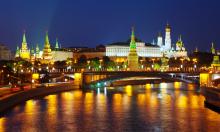Top Shiite cleric arrives in Najaf to end attacks which killed 45
A mortar barrage slammed into a mosque filled with Iraqis preparing to march on the embattled city of Najaf, killing 27 people and wounding 63 here Thursday, hours before the nation's top Shiite cleric arrived at the gates of the holy city in a massive convoy hoping to end three weeks of fighting.
"We are now in Najaf," said Hamed al-Khafaf, an assistant to the Grand Ayatollah Ali Husseini al-Sistani.
In Kufa, Najaf's twin city, unidentified gunmen opened fire from an Iraqi National Guard base on thousands of Shiite Muslim marchers heading to Najaf, killing at least three and wounding 46, witnesses said.
Fierce clashes also continued Thursday in Najaf with U.S. warplanes bombing suspected positions of radical Shiite cleric Muqtada al-Sadr's Mahdi Army militia and explosions booming across the city.
The violence dampened renewed hopes for a rapid resolution to the three-week crisis that has pitted al-Sadr loyalists against a combined U.S.-Iraqi force. The U.S. military and the insurgents both blamed the other for the mortar barrage on Kufa's main mosque, informs Associated Press.
According to Reuters Iraq's top Shi'ite cleric arrived in Najaf Thursday to try to end a bloody three-week uprising as tensions rose sharply following attacks in a nearby town that killed 45 people and wounded 170.
Grand Ayatollah Ali al-Sistani drove into the battered holy city of Najaf in a huge convoy, guarded by dozens of police pickups with their sirens wailing. Scores of police brandished AK-47 rifles as they drove past thousands lining the streets.
The violence in nearby Kufa came as Sistani's efforts to try to persuade fighters loyal to rebel cleric Moqtada al-Sadr to leave Najaf's holiest shrine appeared to be gaining momentum. Sistani would soon unveil a peace plan, his aides said.
Tens of thousands of Iraqis in cars and on foot, many appearing to respond to Sistani's call to rescue the holy city, were converging on Najaf from several regions, witnesses said.
Though some Iraqis have voiced increasingfrustration with Sadr, Sistani's calculations this time are complicated by his awareness that Sadr's appeal has grown, largely because of his staunch anti-U.S. position.
&to=https://newsfromrussia.com/world/2004/08/25/55610.html' target=_blank>Sistani must be careful to find a way to oppose Sadr's use of the shrine without being thrust into the arms of the U.S. military, which is widely disliked in Iraq.
Shiite observers believe that by sticking to a clear message of freeing the shrine of armed men, Sistani can maintain his independence but also be seen as helping all sides reach a solution they can live with.
Subscribe to Pravda.Ru Telegram channel, Facebook, RSS!




